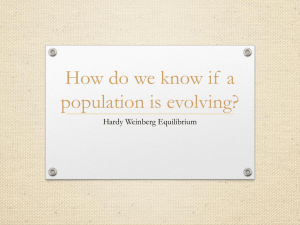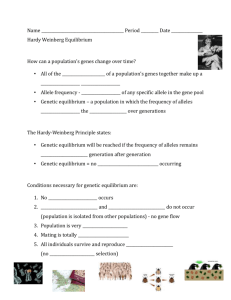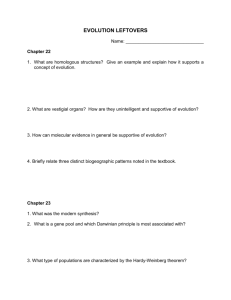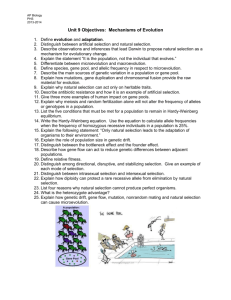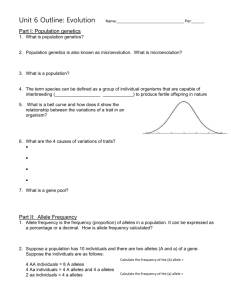Evolution of Populations
advertisement
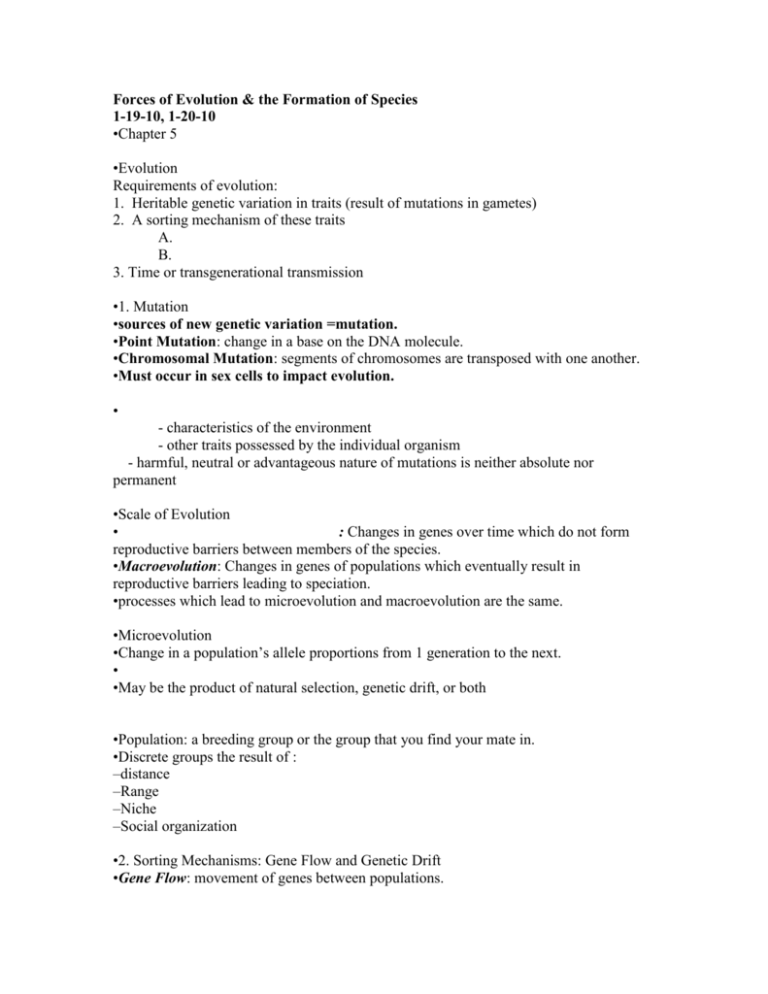
Forces of Evolution & the Formation of Species 1-19-10, 1-20-10 •Chapter 5 •Evolution Requirements of evolution: 1. Heritable genetic variation in traits (result of mutations in gametes) 2. A sorting mechanism of these traits A. B. 3. Time or transgenerational transmission •1. Mutation •sources of new genetic variation =mutation. •Point Mutation: change in a base on the DNA molecule. •Chromosomal Mutation: segments of chromosomes are transposed with one another. •Must occur in sex cells to impact evolution. • - characteristics of the environment - other traits possessed by the individual organism - harmful, neutral or advantageous nature of mutations is neither absolute nor permanent •Scale of Evolution • : Changes in genes over time which do not form reproductive barriers between members of the species. •Macroevolution: Changes in genes of populations which eventually result in reproductive barriers leading to speciation. •processes which lead to microevolution and macroevolution are the same. •Microevolution •Change in a population’s allele proportions from 1 generation to the next. • •May be the product of natural selection, genetic drift, or both •Population: a breeding group or the group that you find your mate in. •Discrete groups the result of : –distance –Range –Niche –Social organization •2. Sorting Mechanisms: Gene Flow and Genetic Drift •Gene Flow: movement of genes between populations. •works in conjunction with natural selection by providing alternatives for a trait. •Example: Sickle cell anemia •genetic drift: random changes in gene frequency in a population. • •Includes the founder effect and bottleneck effect •founder effect: new populations that become isolated from the parent population carry only the genetic variation of the founders. –example:Tristan de Cunha •3. Sorting Mechanism: Natural Selection • •Over time, the population’s allele proportions shift toward the favored type •Differential reproductive success is referred to as fitness •directional selection: selecting for greater or lesser frequency of a trait in a population. •Diversifying selection: •stabilizing selection: maintains a certain phenotype by selecting against deviations from it. •4. Speciation • •species: an interbreeding group of individuals that are reproductively isolated through anatomy, ecology, behavior, or geographic distribution from all other such groups. •Amount of genetic divergence (change) forms a continuum: •How are species formed? •anagenesis: evolution of a species into another over a period of time. –Through directional selection •cladogenesis: evolution of a species through the branching of a species. –Through diversifying selection •Allopatric speciation: speciation occurring from geographic isolation. Parapatric speciation: •The Tempo of Evolution •Gradualism: slow, incremental evolutionary change. •Punctuated Equilibrium: evolution characterized by rapid bursts of change followed by long periods of stasis. •Hardy-Weinberg equilibrium Model •Use equation to measure microevolution in a Mendelian population •Hardy-Weinberg (HW) formula is used to measure changes in allele proportions • •Used to document allele changes for one gene with two alleles •Hardy-Weinberg equilibrium is represented by the following equations: –p2 + 2pq + q2 = 1 –p + q = 1 – p = the frequency of the dominant allele – q = the frequency of the recessive allele –p2 = the frequency of the homozygous dominant individuals –2pq = the frequency of the heterozygous individuals –q2 = the frequency of the homozygous recessive individuals •Example •In an Amish population, you are studying a gene that influences growth •This gene has two alleles: –E = dominant allele, codes for normal growth –e = recessive allele, codes for stunted growth and multiple fingers and toes (polydactyly) •Each person inherits two of these alleles: –EE = homozygous dominant, normal growth and stature –Ee = heterozygous, normal growth and stature –ee = homozygous recessive, dwarfism (Ellis van Crevald Syndrome) •In the HW formula, p = the proportion of E alleles (EE, Ee), and q = the proportion of e alleles (ee) where p + q=1 •If you know that 0.30 (30%) of the population’s alleles are e, then: p + .30 = 1.00 p = 1.00- 0.30 p = 0.70 = the population’s proportion of E alleles p2 + 2pq + q2 = 1.00 •is used to measure changes in proportions of offspring genotypes p2 = p * p = proportion of homozygous dominant offspring (EE) 2pq = 2 * p * q = proportion of heterozygous offspring (Ee) q2 = q * q = proportion of homozygous recessive offspring (ee) •In our example, the E allele has a frequency of 0.70 and the e allele has a frequency of 0.30 •This population would produce 0.70 * 0.70 = 0.49 EE children 2 * 0.70 * 0.30 = 0.42 Ee children 0.30 * 0.30 = 0.09 ee children •Or EE 49%, Ee 42%, ee 9% •compare these to the actual values of the population. The differences we find will document and quantify the nature and amount of genetic drift and selection taking place.
